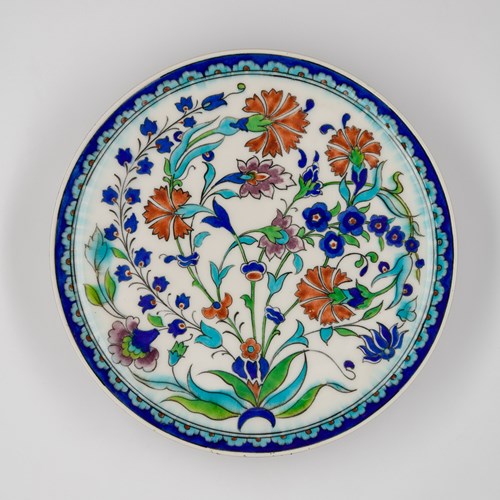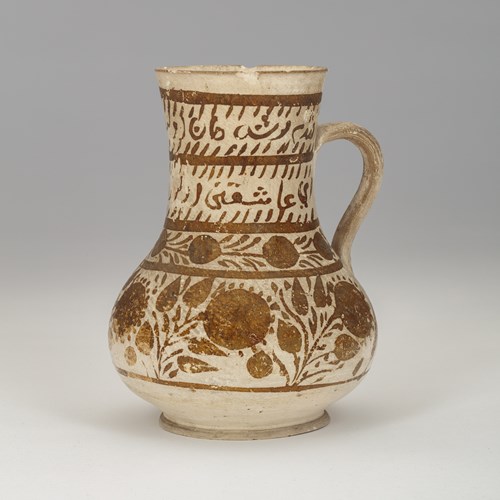Marketplace
Unique Kangxi Huqqa Base Made for the Indian Market
The globular form of this huqqa base derives from 17th century Indian prototypes which were typically made from metal and glass. The collar of red spears derives from ornamentation seen on bidri huqqa bases, such as those pictured in Zebrowski's Gold, Silver, and Bronze from Mughal India.1 Whilst the colour palate and floral ornamentation of the present huqqa base is unique, the bright white glaze and distinctive finish of the base is comparable to examples from Kangxi era China (see Amir Mohtashemi A3518).
The eight red flowers which adorn the huqqa base are those of the palash tree (Butea monosperma), a species of Butea also known as dhak, flame of the forest, and bastard teak. The palash plant is sacred in Hinduism: its use by priests in sacrifices is discussed in the Yajurveda; in Himachal Pradesh it is used in funeral pyres; in Telangana it is used in the worship of Shiva on Shivaratri; its twigs are used to light sacred fires on the occasion of Vastu shanti. As it is an early sign of spring, blooming in late winter with such eye-catching colours, it has become a symbol of renewal, fertility, and lifeforce. The palash tree also has important practical uses. It is home to the lac beetle, whose excreta are collected from the branches of the palash tree and used to make lacquer. Furthermore, the dried flowers are used to create bright yellow dyes, for use during Holi and for applying as a bindi.2
1 Zebrowski, Mark. Gold, Silver, and Bronze from Mughal India. London: Alexandria Press/ Laurence King, 1997. Pp. 229-234. Cat. 371, 375, 376, 379, 389.
2 Jaiswal, Uma. 'Flame of the Forest/Palash', Sacred Trees of Bhu. Retrieved online via http://sacredtreesbhu.com/index.php?id=FlameOfTheForest on 01/05/2024.
The eight red flowers which adorn the huqqa base are those of the palash tree (Butea monosperma), a species of Butea also known as dhak, flame of the forest, and bastard teak. The palash plant is sacred in Hinduism: its use by priests in sacrifices is discussed in the Yajurveda; in Himachal Pradesh it is used in funeral pyres; in Telangana it is used in the worship of Shiva on Shivaratri; its twigs are used to light sacred fires on the occasion of Vastu shanti. As it is an early sign of spring, blooming in late winter with such eye-catching colours, it has become a symbol of renewal, fertility, and lifeforce. The palash tree also has important practical uses. It is home to the lac beetle, whose excreta are collected from the branches of the palash tree and used to make lacquer. Furthermore, the dried flowers are used to create bright yellow dyes, for use during Holi and for applying as a bindi.2
1 Zebrowski, Mark. Gold, Silver, and Bronze from Mughal India. London: Alexandria Press/ Laurence King, 1997. Pp. 229-234. Cat. 371, 375, 376, 379, 389.
2 Jaiswal, Uma. 'Flame of the Forest/Palash', Sacred Trees of Bhu. Retrieved online via http://sacredtreesbhu.com/index.php?id=FlameOfTheForest on 01/05/2024.
Plus d'œuvres d'art de la Galerie







_T638815408614370585.jpg?width=500&height=500&mode=pad&scale=both&qlt=90&format=jpg)

